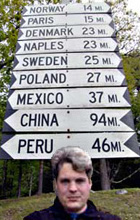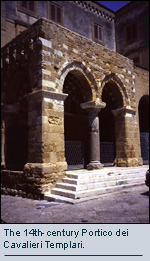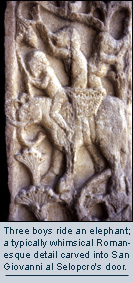Subscribe to the blog 
|
 |
 |
 |
 |
 |
Find a Flight Consider a Consolidator Rent a Car Pick a Railpass Book a Vacation Reserve a Room Get Gear |
|
||||||
|
Brindisi, Waiting Room of the Aegean (cont'd) << back
Pretty disappointing. It only takes about 15 minutes to peruse the modest collections, a fairly unremarkable hodgepodge of doodads from the Stone and Bronze Ages and Roman-era statues and trinkets. There is a pair of AD 1st-century dice, proving that some things about sailors never change, and they save the best for last with a series of fine 4th-century BC bronzes fished out of the sea nearby. Frustrated by the lack of ancient artifacts in this famed Roman town, I decide to try my luck on relics of the early Middle Ages. That's when Brindisi boomed again with the papal legions of millennial crusaders, making the rounds of the alehouses while waiting to embark on the ships that would carry them over to "liberate" the Holy Land. First stop: The 11th-century Knights Templar church of San Giovanni al Sepolcro. The worn reliefs around the door are pretty cool, but there's a rusty padlock on the wooden door, and I can't find anyone with the key, so there's no chance to peek at the 13th-century frescoes inside. I hop on bus 3D and ask the driver to let me off at a bend in the road where Santa Maria del Casale, Brindisi's one saving grace, rises rather incongruously from the midst of the agribusiness flatlands 4km north of town. The 1322 pilgrimage-route church is Romanesque-becoming-Gothic, its facade clad in patterns of zig-zags and chessboards made from alternating tan and milky blue stones. Knights on their way to the Crusades would stop here to pray before boarding their boats, and the frescoes inside—finally, something in Brindisi worth looking at!—were designed to bolster their courage. Colorful but often crudely executed, in styles ranging from static Byzantine to the more expressive Giottesque style that had become all the rage, these New Testament scenes were meant to remind the Crusaders what they were fighting for (on the right of the nave is a Madonna Surrounded by Knights) and what would happen to their eternal souls should their faith fail them (the gruesome Last Judgement filling the end wall).
Copyright © 1998 by Reid Bramblett |

 Hoping
to fare better with what's left of the Roman era in the free Museo Archeologico
Provinciale, I jog up and around the corner to Piazza del Duomo. After
popping inside the 12th-century Cathedral (rebuilt in the 18th century,
but with some original mosaics uncovered near the altar), I duck under
the impressive Portico dei Cavalieri Templari and take the stairs up to
the museum.
Hoping
to fare better with what's left of the Roman era in the free Museo Archeologico
Provinciale, I jog up and around the corner to Piazza del Duomo. After
popping inside the 12th-century Cathedral (rebuilt in the 18th century,
but with some original mosaics uncovered near the altar), I duck under
the impressive Portico dei Cavalieri Templari and take the stairs up to
the museum.  The
one good sightseeing tip I have isn't even located in town, so I head
back to the train station to catch a bus. While I wait, I chat with the
staff of a cheerily-painted trailer who are handing out sightseeing and
pamphlets and fliers with discount hotel and restaurant coupons aimed
at convincing the backpacking students, who periodically pour out of the
station doors, to spend at least one night here in town and spend money
on something more than a ferry ticket and a slice of god-awful pizza from
parlors lit by nudie-girl neon.
The
one good sightseeing tip I have isn't even located in town, so I head
back to the train station to catch a bus. While I wait, I chat with the
staff of a cheerily-painted trailer who are handing out sightseeing and
pamphlets and fliers with discount hotel and restaurant coupons aimed
at convincing the backpacking students, who periodically pour out of the
station doors, to spend at least one night here in town and spend money
on something more than a ferry ticket and a slice of god-awful pizza from
parlors lit by nudie-girl neon.

